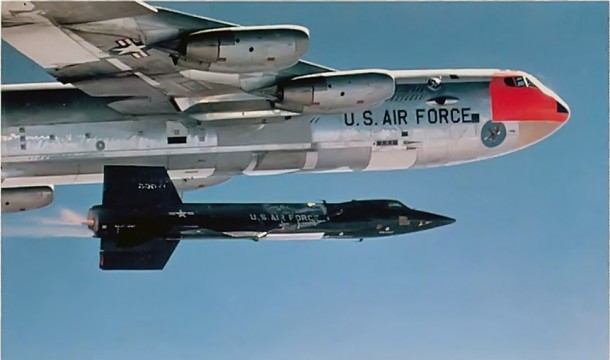
Fifty-six years ago today, the USAF/NASA/North American X-15 became the first manned aircraft to exceed Mach 6. United States Air Force test pilot Major Robert M. White was at the controls of the legendary hypersonic flight research aircraft.
The North American X-15 was the first manned hypersonic aircraft. It was designed, engineered, constructed and first flown in the 1950’s. As originally conceived, the X-15 was designed to reach 4,000 mph (Mach 6) and 250,000 feet. Before its flight test career was over, the type would meet and exceed both performance goals.
North American built a trio of X-15 airframes; Ship No. 1 (S/N 56-6670), Ship No. 2 (56-6671) and Ship No. 3 (56-6672). The X-15 measured 50 feet in length, had a wing span of 22 feet and a GTOW of 33,000 lbs. Ship No. 2 would later be modified to the X-15A-2 enhanced performance configuration. The X-15A-2 had a length of 52.5 feet and a GTOW of around 56,000 lbs.
The Reaction Motors XLR-99 rocket engine powered the X-15. The small, but mighty XLR-99 generated 57,000 pounds of sea level thrust at full-throttle. It weighed only 910 pounds. The XLR-99 used anhydrous ammonia and LOX as propellants. Burn time varied between 83 seconds for the stock X-15 and about 150 seconds for the X-15A-2.
The X-15 was carried to drop conditions (typically Mach 0.8 at 42,000 feet) by a B-52 mothership. A pair of aircraft were used for this purpose; a B-52A (S/N 52-003) and a B-52B (S/N 52-008). Once dropped from the mothership, the X-15 pilot lit the XLR-99 to accelerate the aircraft. The X-15A-2 also carried a pair of drop tanks which provided propellants for a longer burn time than was possible with the stock X-15 flight.
The X-15 employed both aerodynamic and reaction flight controls. The latter were required to maintain vehicle attitude in space-equivalent flight. The X-15 pilot wore a full-pressure suit in consequence of the aircraft’s extreme altitude capability. The typical X-15 drop-to-landing flight duration was on the order of 10 minutes. All X-15 landings were performed deadstick.
On Thursday, 09 November 1961, USAF Major Robert M. White would fly his 11th X-15 mission. The X-15 and White had already become respectively the first aircraft and pilot to hit Mach 4 and Mach 5. On this particular day, White would be at the controls of X-15 Ship No. 2. The planned maximum Mach number for the mission was Mach 6.
At 17:57:17 UTC of the aforementioned day, X-15 Ship No. 2 was launched from the B-52B mothership commanded by USAF Captain Jack Allavie. Bob White lit the XLR-99 and pulled into a steep climb. Mid-way through the climb, White pushed-over and ultimately leveled-off at 101,600 feet. XLR-99 burnout occurred 83 seconds after ignition. At this point, White was traveling at 4,093 mph or Mach 6.04.
On this record flight, the X-15 was exposed to the most severe aerodynamic heating environment it had experienced to date. Decelerating through Mach 2.7, the right window pane on the X-15’s canopy shattered due to thermal stress. The glass pane remained intact, but White could not see out of it. Fortunately, he could see out of the left pane and made a successful deadstick landing on Rogers Dry Lake at Edwards AFB.
For his Mach 6+ flight, Bob White was a recipient of both the 1961 Collier Trophy and the Iven C. Kincheloe Award. The year before, White had received the Harmon Trophy for his X-15 flight test work. He would go on to fly the X-15 to a still-standing FAI altitude record of 314,750 feet in July of 1962. For this accomplishment, White was awarded USAF Astronaut Wings.
Bob White flew the X-15 a total of sixteen (16) times. He was one (1) of only twelve (12) men to fly the aircraft. White left X-15 Program and Edwards AFB in 1963. He went on to serve his country in numerous capacities as a member of the Air Force including flying 70 combat missions in Viet Nam. He returned to Edwards AFB as AFFTC Commander in August of 1970.
Major General Robert M. White retired from the United States Air Force in 1981. During his period of military service, he received numerous decorations and awards including the Air Force Cross, Distinguished Service Medal, Silver Star with three oak leaf clusters, Legion of Merit, Distinguished Flying Cross with four oak leaf clusters, Bronze Star Medal, and Air Medal with 16 oak leaf clusters.
Bob White was a true American hero. He neither sought nor received much notoriety for his many accomplishments. He served his country and the aviation profession well. Bob White’s final flight occurred on Wednesday, 17 March 2010. He was 85 years of age.

